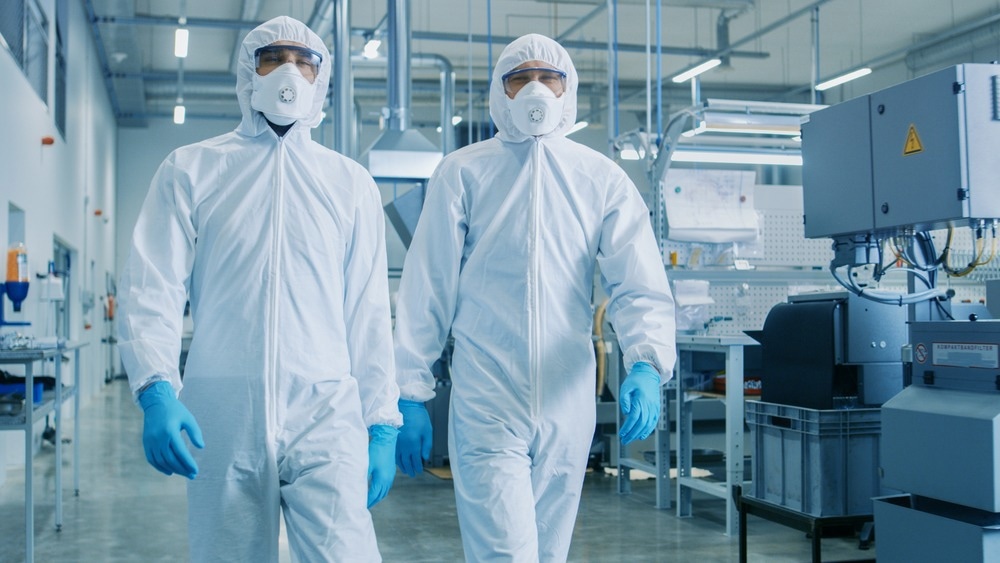Cleanrooms are highly controlled spaces that are maintained under stringent cleanliness. In this article, the use of robots in cleanroom environments is discussed.

Image Credit: Gorodenkoff/Shutterstock.com
What Are Cleanrooms?
Cleanroom cleanliness standards are extremely high to eliminate any possibility of contamination in the final product. These contaminants may be in the form of microorganisms, biomolecules, as well as inorganic particles that may impact the quality of the manufactured process.
When cleanrooms are used in the manufacturing of electronic devices, such as microelectronics and semiconductors, particulate-controlled measures are typically applied. Conversely, biocontamination-controlled measures are utilized in cleanrooms that support manufacturing food, pharmaceutical, medical, and aeronautic products.
Modern cleanrooms typically filter any outdoor air that enters the room. In contrast, air within the cleanroom is constantly being recirculated through high-efficiency particulate air (HEPA) and ultra-low particulate air (ULPA) filters. Additionally, most cleanrooms are maintained at higher temperatures than the external environment to limit any inadvertent air flow into the facility.
In addition to temperature and air quality, some other environmental parameters are controlled within cleanrooms. Parameters include humidity, light sources, electrostatics, electromagnetics, and the number of particles in the room. While air conditioning systems typically control humidity levels within cleanrooms, cleaning, disinfection, and surface sterilization procedures can control particle levels present within the room. Electrostatic and electromagnetic levels can also be controlled by deduction, ground connections, ionization, as well as architectural plans.
Challenges With Cleanrooms
Despite the precise efforts that are made to ensure the sterility of cleanrooms, there are many ways in which contaminants can enter these rooms. For example, the movement of personnel in cleanrooms as they perform certain tasks can significantly impact internal airflow rates.
Within intensive care unit (ICU) rooms, previous studies have also found that despite efficient cleaning practices and the use of appropriate disinfectants, multidrug-resistant organisms can still persist on hospital surfaces.
Outdoor climate changes may also impact indoor temperature and humidity levels; thus, construction designs that have not considered these potential factors also threaten the manufacturing processes conducted within cleanrooms.
The Promise of Cleanroom Robots
Several different technologies have been proposed to resolve factors threatening the sterility of cleanrooms. Automatic processes that are conducted in cleanrooms have been proposed to limit human contact with the products, thus reducing the likelihood of contamination and other human errors.
In 2016, the Onze Lieve Vrouqe Gasthuis (OLVG) hospital in Amsterdam purchased a cytotoxic compounding robot known as APOTECAchemo for producing cytostatic drugs that require strict aseptic conditions.
Since these drugs are often used to treat oncology patients who are at an increased risk of infection, ensuring the microbiological stability of these injectable preparations is imperative. Furthermore, eliminating the use of pharmacy technicians to compound these cytostatic drugs also minimizes their exposure to these hazardous substances.
In a 2022 study assessing the effectiveness of APOTECAchemo in producing sterile cytostatic solutions, researchers reported that none of the 96 media fill preparations, nor any of the 300 syringes, exhibited any signs of microbiological contamination. In addition to successfully meeting the European good manufacturing practice (GMP) standards, APOTECAchemo was also found to successfully reuse vials repeatedly without compromising the integrity of the final drug formulation.
The IAI selective compliance assembly robot arm (SCARA) commercial robots are compact and powerful systems ideal for cleanroom environments. More specifically, the air inside the SCARA robots can be exhausted to create negative pressure when in use, thus minimizing dust production in sterile settings.
Another commercial cleanroom robot is the LR Mate 200iD/7C Clean Room Robot produced by Fanuc. This compact multi-purpose six robot is water- and dust-proof, thus making it an ideal solution for cleanrooms. Although LR Mate 200iD/7C Clean Room Robot can be used for a wide range of industries, it is ideal for cleanrooms where small electronics components and pharmaceutical products are handled.
Future Outlook of Robotics in Cleanrooms
Robotic systems offer researchers and manufacturing companies the ability to minimize human error, bacterial contamination, and unwanted particulate movement within cleanrooms. Despite the advantages conferred by these systems, many other factors may contribute to possible sources of contamination that cannot be completely eliminated through robotics.
In fact, one simulation study found that the velocity of the SCARA and its supplied air still led to nonuniformity within the cleanroom. Although adjusting certain variables such as the blowing ratio of the supplied air, the height of the SCARA system, and the grid porosity of the cleanroom could reduce this nonuniformity to improve cleanliness, the maintenance of cleanrooms remains challenging.
References and Further Reading
Mora, M., Mahnert, A., Koskinen, K., et al. (2016). Microorganisms in Confined Habitats: Microbial Monitoring and Control of Intensive Care Units, Operating Rooms, Cleanrooms and the International Space Station. Frontiers in Microbiology 13. doi:10.3389/fmicb.2016.01573.
Mahnert, A., Vaishampayan, P., Probost, A. J., et al. (2015). Cleanroom Maintenance Significantly Reduces Abundnace but Not Diversity of Indoor Microbiomes. PLoS One 10(8); e0134848. doi:10.1371/journal.pone.0134848.
Geersing, T. H., Franssen, E. J. F., Pilesi, F., & Crul, M. (2019). Microbiological performance of a robotic system for aseptic compound of cytostatic drugs. European Journal of Pharmaceutical Sciences 130; 181-185. doi:10.1016/j.ejps.2019.01.034.
Liu, K., Hao, M., Li, B., et al. (2022). Optimization on flow field in an operational cleanroom subject to kinematic component and structural parameters. Journal of Building Engineering 59. doi:10.1016/j.jobe.2022.105152.
Mendes, A. S. P., Rutgersson, A., & Paulsson, M. (2022). Outdoor environmental effects on cleanrooms – a Study from a Swedish hospital pharmacy compounding unit. European Journal of Pharmaceutics and Biopharmaceutics 177; 100-106. doi:10.1016/j.ejpb.2022.06.003.
SCARA Robot in Cleanroom-compatible Design [Online]. Available from: https://www.iai-automation.com/en/scara-robots-cleanroom.html.
FANUC LR Mate 200iD/7C Clean Room Robot [Online]. Available from: https://www.fanucamerica.com/products/robots/series/lr-mate/lr-mate-200id-7c-cleanroom-robot.
Disclaimer: The views expressed here are those of the author expressed in their private capacity and do not necessarily represent the views of AZoM.com Limited T/A AZoNetwork the owner and operator of this website. This disclaimer forms part of the Terms and conditions of use of this website.